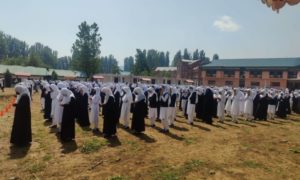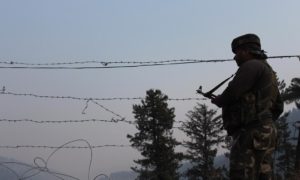As a disturbing pattern trailing increasing military operations in the valley, enforced homelessness has alarmingly risen in the region. Before being blasted for sheltering insurgents or falling in the combat zone, many of these homes were repositories of life and liveliness—now reduced to ruined symbols of the unabated conflict.
On a routine summer day in 2018, I revisited my roots, in my native Yaroo village, nestled miles away, north of the capital Srinagar. The village wore the typical countrified look, where simpletons were defying the sense of heightened vigil through their unassuming activities. But behind that normal retreating image, as it shortly unearthed, the village was trying to overcome—if not to conceal—the enforced tragedy.
A posse of counterinsurgents had shown up there, in dozens, a fortnight before my arrival, to launch a cordon and search operation. What followed was the quite characteristic of the counterinsurgent ops in Kashmir.
A residence, presumably a “safe house” for insurgents, was blasted. The guns had roared and shattered the idyllic calm of the village, just two days before Eid.
Shortly, I was at the ruined site. There were no traces of what the doomed family knew as their home, just before the gunners appeared—acting on a tip-off—to confront their ill-equipped, ill-trained counterparts.
In the background of heartbreaking destruction, I stood like a freeze frame, mulling over the uncertain times ahead of the fated family.

Image credits: Faizan Bhat
In front of me was a bullet-torn tin-devaar—aluminium fence. As the first line of defence for the fallen residence, it had faced a full-scale offensive.
A villager told me about the family’s cow — charred alive in the combat. Her carcass lay under the burnt bricks, near the smoked debris of the house, adjacent to wasted clothes covered in soot. It was a sight of sheer terror.
It was hard to fathom the devastating psychological effects of enforced-homelessness on the psyche of the family.
ALSO READ: Photo Essay: A ravaged account from Budgam’s blasted site
Post-2016 street uprising, the wailing landscape of Kashmir has been witnessing an alarming rate of enforced homelessness. Many videos—shot seconds before the blast that went viral on social media—show residences rising up in flames and smoke. Such alarming visuals reminds many of the “dirty war” remark by Indian army chief, Bipin Rawat.
In an era of “Op All Out”, the rampant blasting of houses during gunfights and cross-firings became another addition in Kashmir, apart from bruised bodies, scarred faces and assaulted eyes.
Often, as the last gun falls silent and armed forces walk away with their lifeless nemesis, homeless families remain at the mercy of fellow villagers and relatives, who provide them shelter on a temporary basis.
There’s no official record for how many homes have been destroyed in Kashmir since the beginning of armed upheaval in the late 1980s.
Last year, in an interview with Al Jazeera, Rajesh Yadav, a spokesperson of the Central reserve police force (CRPF), said that it’s easier for them to blow up the small houses in which the militants are hiding rather than ‘engage in a drawn out gun-fight’.
In the same report, a senior police official justified the ‘causalities’ suffered by civilians in this process, claiming that they are ‘militant sympathizers’ and deserve the treatment they get.
The uncertainty of loss, whether of lives or property, has led Kashmiris into a sense of constant despair. There’s no compensation from the government, particularly if the families had given shelter to the militants or if the state forces claim so.
There’ve also been claims of “war booty”. However, authorities often deny these claims, without ordering any serious investigation.

Ruins of a residential house after a gunfight in Budgam. (FPK Photo/Wasim Nabi)
As matter of routine now, neighbours of these families go for crowd-funding to re-shelter them. But the cost of rebuilding houses is very high and therefore takes several years for people to do so, especially in circumstances where they’ve lost everything.
In Kashmir, people spend their lives building houses, often saving money for years to install a new wardrobe or a new lighting system in the house. But all this turns into debris and smoke, if it fares on intelligence radars, or falls in the combat zone.
ALSO READ: 2018: The year of funerals, political coups, and burning homes
Most of the times, important valuables in the form of birth and degree certificates, are wasted along with the rest of the things, forcing families to run back and forth from one government office to other.
Along with this state of enforced suffering, Kashmir’s perpetual state of political uncertainty has to end. The lingering dynamics of the oldest post-colonial problem has already battered the picturesque landscape of the valley beyond recognition.
As I saw it in my native village, it’s easy to rebuild a house, but it takes a lifetime to make it a home. And blasting that very home, during combat, only leaves a trail of trauma behind.
Like this story? Producing quality journalism costs. Make a Donation & help keep our work going.










